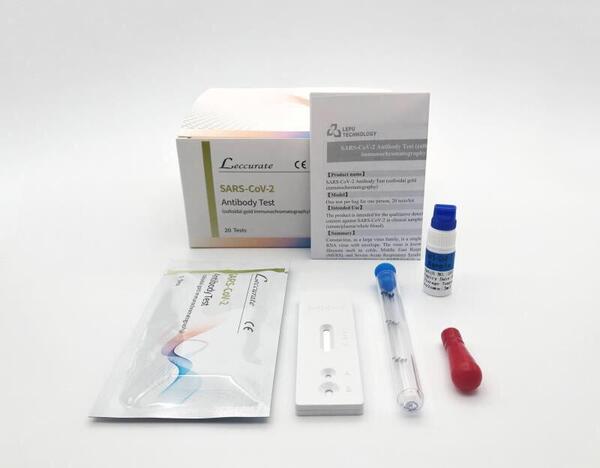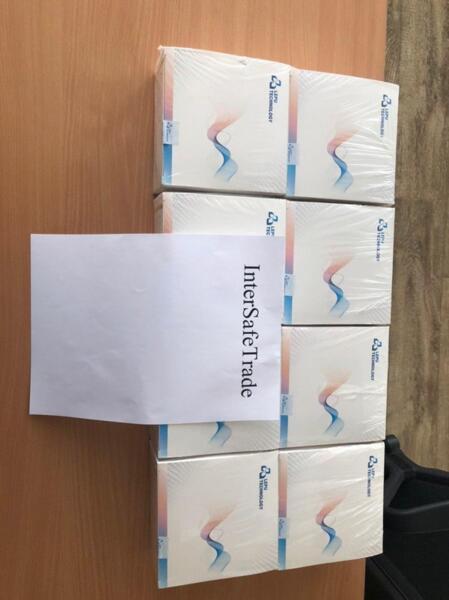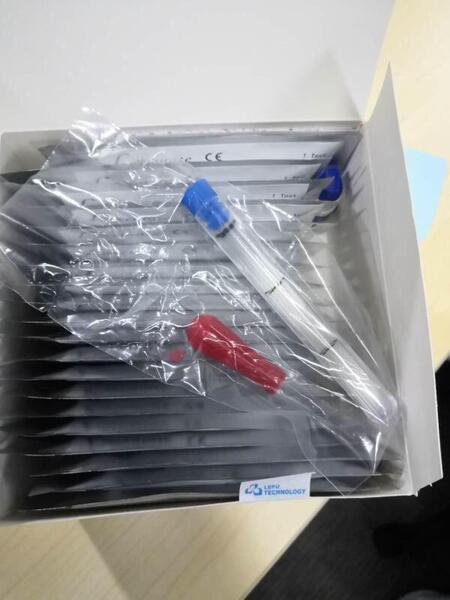Тест COVID-19 IgM/igM Ab

Тест igM / IgG Ab на определение коронавирусной инфекции. Используется для качественного определения антител IgM и IgG к 2019Ncov в сыворотке, плазме человека или цельной крови.
Купить оптом тесты на коронавирус можно через нас. Минимальная партия: 12 000 штук
Product name:
SARS-CoV-2 Antibody Test (colloidal gold immunochromatography)
Model:
One test per bag for one person, 20 tests/kit
Intended Use:
The product is intended for the qualitative detection of antibody content against SARS-CoV-2 in clinical samples (serum/plasma/whole blood).
Summary:
Coronavirus, as a large virus family, is a single positive stranded RNA virus with envelope. The virus is known to cause major illnesses such as colds, Middle East Respiratory Syndrome (MERS), and Severe Acute Respiratory Syndrome (SARS). The novel virus, now known as SARS-CoV-2, was discovered in Wuhan virus pneumonia cases in 2019, and was officially named by the World Health Organization on January 12, 2020. The core protein of SARS-CoV-2 is the N protein (nucleocapsid), which is a protein component located inside the virus. It is relatively conserved among β-coronaviruses and is often used as a tool for the diagnosis of coronaviruses. ACE2, as a key receptor for SARS-CoV-2 to enter cells, is of great significance for the research of viral infection mechanism.
Measurement Principle:
The product is based on the principle of antigen-antibody reaction and immunoassay technique. The test device contains colloidal gold labeled SARS-CoV-2 recombinant protein, mouse-anti human IgG antibody immobilized in G test area, mouse-anti human IgM antibody immobilized in M test area and the corresponding antibody in quality control area (C). During the test, when the SARS-CoV-2 IgM antibody level in the sample is at or above the limit of detection of the test, the SARS-CoV-2 IgM antibody in the sample binds to the colloidal gold labeled SARS-CoV-2 recombinant protein which is pre-coated on a gold label pad. The conjugates migrate upward through capillary effect and would be captured by mouse-anti human IgM antibody immobilized in M test area subsequently and this produces a purple-red band appears in the M test area.
When the SARS-CoV-2 IgG antibody level in the sample is at or above the limit of detection of the test, the SARS-CoV-2 IgG antibody in the sample binds to the colloidal gold labeled SARS-CoV-2 recombinant protein which is pre-coated on a gold label pad. The conjugates migrate upward through capillary effect and would be captured by mouse-anti human IgG antibody immobilized in G test area subsequently and this produces a purple-red band appears in the G test area. If it is a negative sample, there is not a purple-red band appeared in the M and G test area. Regardless of the presence or absence of the SARS-CoV-2 antibody in the sample, a purple-red band will appear in the quality control area (C). The purple-red band in the quality control area (C) is a criterion for judging whether there is enough sample and whether the chromatography process is normal. It also serves as the internal control standard for reagents.
Components:
The product contains 20 tests, one IFU (instruction for use) and one lot number card. For each test, it contains one testing strip, one dropper and one package of desiccant. The testing strip is composed of one gold standard mat (colloidal gold labeled SARS-CoV-2 recombinant protein), sample mat, cellulose nitrate membrane (Mouse-anti human IgM antibody immobilized in M area, Mouse-anti human IgG antibody immobilized in G area; Goat anti-mouse antibody immobilized in C area), absorbing paper, plastic carrier board.
Storage and Stability:
It should be stored at 4℃~ 30℃, be kept dry and away from sunlight. The shelf life is 12 months. For per test strip, it should be used within 1 hour after unsealing. Production Date and Expiration date are shown in the package label.
Sample Requirements:
The test strip can be performed with serum/plasma/whole blood. The blood should be collected by professional medical staff, and it is advised of detecting serum/plasma in priority, and under emergency conditions or special conditions, the whole blood of patients can be used for rapid testing. After collection of samples, it should be tested immediately. It is forbidden for long time placement of the sample under room temperature. For whole blood sample, if it can not be tested in time, it can preserve for 24 hours between 2 and 8 ℃ . Serum/plasma samples can be preserved for 3 days under temperature between 2 and 8℃, and for long time storage, they should be stored under -20℃, and it should avoided repeated freeze-thaw cycles.
Before testing, the sample must be restored to room temperature, ready for application only after homogeneity. The sample must be returned to room temperature before testing, and should be used after mixing. Do not use samples with severe hemolysis, severe lipids, and jaundice.
Test Method:
Please read the instruction for use carefully before performing the test. Before testing, restore the reagents and blood sample to room temperature. 1. Remove the test strip from the packaging reagent bag and use it within 1 hour, especially in an environment with room temperature higher than 30 ° C or in high humidity. 2. Place the kit on a clean platform.
⚫ Serum or plasma sample: Add 10 uL of serum or plasma sample to well A, and then add two drops (about 80 uL) of sample dilution to well B, and start timing.
⚫ Whole blood sample: Add 20 uL of whole blood sample to sample well A, and then add two drops (about 80 uL) of sample dilution to sample well B, and start timing. 3. Wait for the fuchsia band to appear. The test results should be read within 10-20 minutes. Do not read the results after 20 minutes.
The Explanation of the Testing Results:
⚫ Positive (+): There appear purple stripes in both quality control area and either area M or G.
⚫ Negative (-): There is only one purple stripe in the quality control area (C), and without purple stripe in either test area M and test area G.
⚫ Invalid: There is no purple stripe in the quality control area (C), indicating incorrect operating procedures or the testing strip has already deteriorated. Under this conditions, it must read the instruction for use again carefully, and then use the new test strips to test again. If the problem still exists, stop using this lot number immediately and contact the local suppliers.



